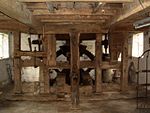Wimbolds Trafford
Cheshire West and ChesterEngvarB from July 2016Former civil parishes in CheshireVillages in Cheshire

Wimbolds Trafford is a hamlet and former civil parish, now in the parish of Mickle Trafford and District, in the unitary authority area of Cheshire West and Chester and the ceremonial county of Cheshire, England. The hamlet lies on the B5132 road, approximately 5 miles (8 km) to the north east of Chester and north of the village of Mickle Trafford. (grid reference SJ44) At the 2011 census the civil parish had a population of 212.
Excerpt from the Wikipedia article Wimbolds Trafford (License: CC BY-SA 3.0, Authors, Images).Wimbolds Trafford
Ince Lane, Chester Mickle Trafford and District
Geographical coordinates (GPS) Address Nearby Places Show on map
Geographical coordinates (GPS)
| Latitude | Longitude |
|---|---|
| N 53.246 ° | E -2.829 ° |
Address
Ince Lane
Ince Lane
CH2 4JL Chester, Mickle Trafford and District
England, United Kingdom
Open on Google Maps










